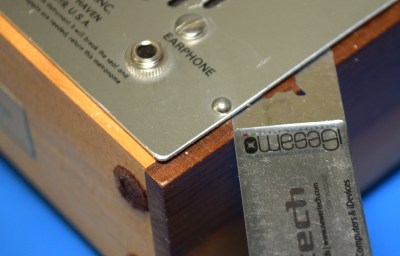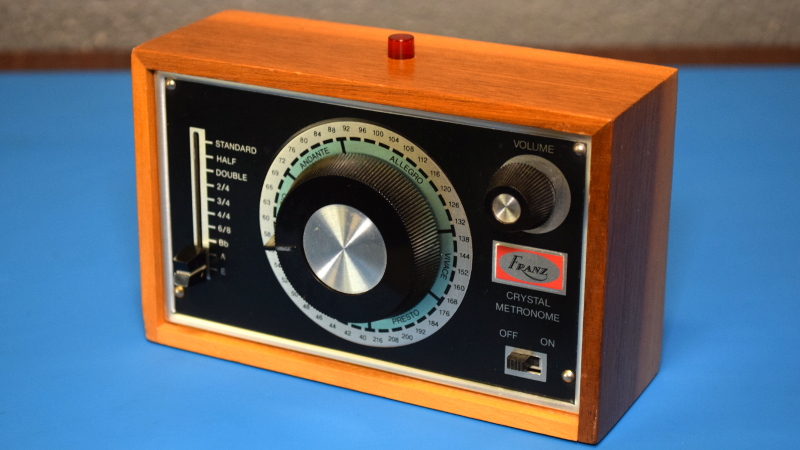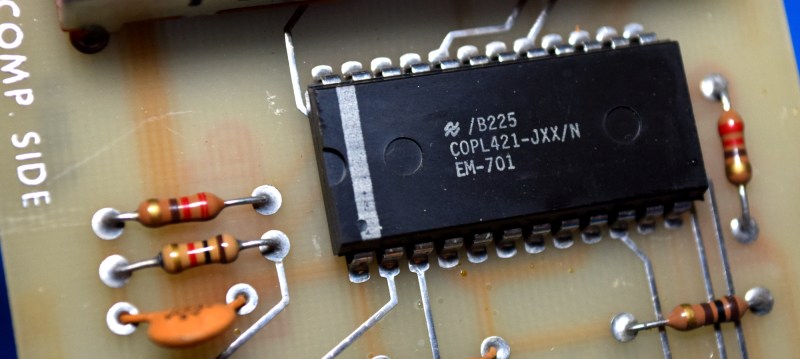I wish I could tell you that there’s some complex decision tree at play when I select a piece of hardware to take apart for this series, but ultimately it boils down two just two factors: either the gadget was something I was personally interested in, or it was cheap. An ideal candidate would check both boxes, but that’s not always the case. This time around however, I can confidently say our subject doesn’t fall into either category.
Now don’t get me wrong, at first glance I found the Franz Crystal Metronome to be intriguing in its own way. With that vintage look, how could you not? But I’m about as far from a musician as one can get, so you’d hardly find a metronome on my wish list. As for the cost, a check on eBay seems to show there’s something of a following for these old school Franz models, with ones in good condition going for $50 to $80. Admittedly not breaking the bank, but still more than I’d like to pay for something that usually ends up as a pile of parts.
That being the case, why are you currently reading about it on Hackaday? Because it exploits something of a loophole in the selection process: it doesn’t work, and somebody gave it to me to try and figure out why. So without further ado let’s find out what literally makes a Franz Crystal Metronome tick, and see if we can’t get it doing so gain.
For a More Civilized Age
Thanks at least in part to the selection criteria I outlined earlier, the build quality of most of the devices we’ve looked at in this series thus far has been questionable at best. With few exceptions, injection molded plastic and hot glue have been the artisan’s tools of choice. But this? This is something very different. For the first time, we have on the bench a piece of consumer electronics nestled into an solid wood enclosure that’s held together with actual nails. Nails!

I understand this might not be quite as exciting for some of the more temporally experienced hardware hackers out there, but for those of us who had to read about the Moon landing in the history books, it’s pretty wild. I wouldn’t go so far as to say that I actually like the idea, after all, prying all the nails out without scratching or denting the thing took considerable effort. But I can certainly see the appeal.
Put simply, the Franz Crystal Metronome is gorgeous. Its heft combined with the resounding clicks and snaps of the dials and switches on the front panel gives the impression of quality, and it genuinely feels like something you’d be proud to own and display in your home. Whatever this gadget cost originally was money well spent, and compared to the cheapo digital metronomes on the market today, I can absolutely see why some people are willing to pay a premium for one on eBay. All the more reason to get it back in working order.
Dead Trees and ICs
Getting the PCB out of the Franz Crystal Metronome requires you to take the device completely apart, which means pulling out all the nails on the front and back as well as uncovering the three screws hidden under the felt feet on the bottom. When all the fasteners are out, the case slides apart like some kind of puzzle box. It’s clever, but not exactly convenient.
I expected to see some kind of oddball vintage components inside, but the board is actually quite simple. Beyond a handful of passives, the star of the show is a National Semiconductor COPL421, a low-power entry into the COP400 family of 4-bit microcontrollers. Introduced in 1978, these chips were fairly common in early 80s electronic devices, and there’s a fair bit of information online about dumping the firmware from them should you be so inclined.
It’s interesting to note that, according to the COPL421 datasheet, one of the improvements of the low-power version is a wider operating voltage — 4.5 V to 9.5 V — compared to the standard COP400. That explains why there’s no obvious power regulation on the board, just a 100 Ω resistor between the chip and the 9 V battery that powers the metronome. Sure enough, with a fresh battery installed, the VCC pin reads roughly 8.9 V.

Now if you’re like me, you may be asking yourself where the crystal is. After all, the thing is called a “Crystal Metronome” right? Well I can only assume the name refers to the yellow CSB 455 down at the bottom of the board, a 455 kHz oscillator being used as the clock source for the COPL421. But while this component is critically important to the timing of the metronome itself, it’s actually a ceramic resonator and not a quartz crystal as we were promised.
It feels good to bring the vicious lies of the Franz corporation to the public after all these years. Though to be fair, “Franz Ceramic Resonator Metronome” doesn’t have nearly the same ring to it.
The Beat Goes On
At the top of this teardown, I said that the metronome was given to me in hopes that I could get it working again. After a quick once over confirmed the device was dead, a close inspection revealed the culprit in short order. Unfortunately, the fix is not nearly as exciting as you’re probably hoping.
It turns out that after a few decades of service, the 9 V battery contacts had badly corroded. With a trip to the parts bin and a few taps of the soldering iron, a new connector was in place and the device fired right up. I considered replacing the capacitors since they’re often suspect after so many years of service, but thanks to the relatively light duty these have seen, there were no obvious signs of failure. That said, should it start acting up again, the capacitors will be the prime suspect.
So at least for the time being, I’m happy to report that the Franz Crystal Metronome is in working condition and back with its original owner. Doing, you know…whatever the hell a metronome does.


















Good to see that another one of these is kept ticking along
A repair pictorial without even a picture of the failed part?
That said, nice teardown.
My guess is that you chose this project just so you could use the line “find out what literally makes a Franz Crystal Metronome tick”. Nice.
Nice to see the Franz Manufacturing Company getting a ticking off for misrepresentation.
That part could be as bad as a 1% cumulative frequency error – allegroledgedly.
take your facepalm and get out
Nice!
You have to pull nails to change a battery?
I believe there’s a battery door that’s part of the back, that comes off without removing nails.
Sorry, the bottom plate has a cutout and a small battery door that’s secured with a screw. Realizing now I forgot to include it in the “exploded” view, so I can understand the confusion.
I wonder what change in Tempo an Excellent musician or conductor can detect. Perhaps there have been studies on a humans ability to sense tempo changes. But I bet a 1% tempo change would be hard to notice.
I have an electronic metronome that has setting increments of about 4%. I can definitely hear the difference between 100 BPM and 104 BPM, but only if I hear the tempos one immediately after the other. I could probably discern finer increments, but I’m not sure I could pick out 1% changes. I am absolutely certain that if I heard a random tempo between 100 and 104 BPM, in isolation, with no reference, I would not know which tempo it was.
I think it’s similar to pitch. I know I can reliably hear pitch changes of half a percent. But if you play a note in isolation, with no reference, I’m lucky to be able to tell you which note on the scale it is.
I believe stability is more important than absolute accuracy, and a ceramic resonator is reasonably stable as long as the temperature isn’t changing rapidly. It’s probably better than most mechanical metronomes, and definitely better than my ear.
Leave Mr Franz Crystal alone! He’s allowed to name products after his full name :P
Apparently Bela Bartok could: “He was equipped with an uncannily accurate inner clock and he could tell when music marked to be played at metronome 112 was in fact going at 111 or 113.”
Maybe you should have replaced the caps, since it sounds like such an S.O.B. to take apart.
Check out their electro-mechanical metronomes. Much more fun inside.
This article used the name “Franz Crystal Metronome” 10 times, including the title. It is a memorable name, I’ll admit.